#the fourth for a collection inspired in childhood series (my little pony in my case)
Explore tagged Tumblr posts
Text
Random moodboards that i made for school









#the first was for a wool loom#the second and third for a jacket inspired in greek mitology and culture#the fourth for a collection inspired in childhood series (my little pony in my case)#the fifth about victor von schwartz#Victor is my favourite fashion designer#then there's Dolce and Gabanna moodboard#Valentina Karnoubi moodboard#Ryan Lo moodboard#my prom dress moodboard#moodboards#fashion design
5 notes
·
View notes
Photo
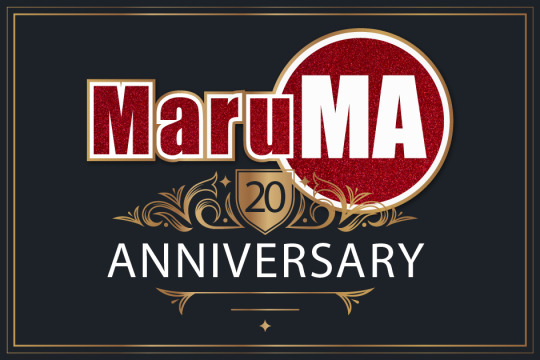

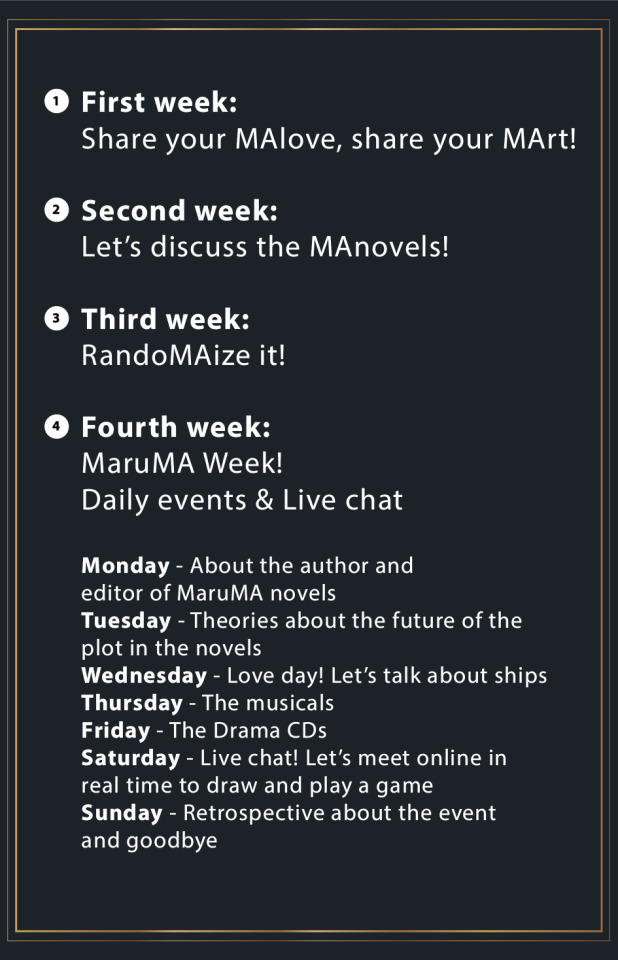

Hello Everyone!
A day like today 20 years ago the first novel of our beloved series was published in November 2000. This is an incredible anniversary and that’s why we’ll celebrate the whole month with events!
I hope you can join this special occasion and contribute a little bit by sharing your posts and art here in tumblr.
This is not the first event run by this blog, if you want to see what we did in previous years you can visit my tags MA Event, MA Event 2017 and MA Event 2018.
The dynamic of the events is to have some deliver themes and inspiration divided in different sections. This event will run weekly, except for the last week of the month when we’ll have daily content shared to inspire you even more.
Please save the date around the last weekend of November for our Live Chat! I’ll post more information about the exact date and time along the next weekly posts.
Update: Live Chat Sunday 29 at 1am Buenos Aires timezone GTM-3 You can check online comparing with your time zone here. We’ll meet and chat, share opinions, and play some games or draw together!
20th Anniversary MA Event - First Week Activity Share your MAlove, share your MArt! From November 1 to November 8
This week we’ll draw fanarts, write fanfics or make any other kind of media to celebrate the 20th anniversary of the series. We have list of 365 prompts in case you need a little bit of extra inspiration, please check under the cut and try to mix anything you pick with a festive mood to make it really special ;D
Remember to tag your posts with #MAnniversary 2020 and #MA Event
Links to the weekly event’s posts:
First Week (in this post) Second Week Third Week Fourth Week | Monday | Tuesday | Wednesday | Thursday | Friday | Saturday | Sunday
Prompts:
01. Introduction
02. Love
03. Light
04. Dark
05. Seeking Solace
06. Break Away
07. Heaven
08. Innocence
09. Drive
10. Breathe Again
11. Memory
12. Insanity
13. Misfortune
14. Smile
15. Silence
16. Questioning
17. Blood
18. Rainbow
19. Gray
20. Fortitude
21. Vacation
22. Mother Nature
23. Cat
24. No Time
25. Trouble Lurking
26. Tears
27. Foreign
28. Sorrow
29. Happiness
30. Under the Rain
31. Flowers
32. Night
33. Expectations
34. Stars
35. Hold my Hand
36. Precious Treasure
37. Eyes
38. Abandoned
39. Dreams
40. Rated
41. Teamwork
42. Standing Still
43. Dying
44. Two Roads
45. Illusion
46. Family
47. Creation
48. Childhood
49. Stripes
50. Breaking the Rules
51. Fanart
52. Deep in Thought
53. Keeping a Secret
54. Tower
55. Waiting
56. Danger Ahead
57. Sacrifice
58. Kick in the Head
59. No Way Out
60. Rejection
61. Fairy Tale
62. Magic
63. Do Not Disturb
64. Multitasking
65. Horror
66. Traps
67. Playing the Melody
68. Hero
69. Annoyance
70. 67%
71. Obsession
72. Mischief Managed
73. I Can’t
74. Are You Challenging Me?
75. Mirror
76. Broken Pieces
77. Test
78. Drink
79. Starvation
80. Words
81. Pen and Paper
82. Can You Hear Me?
83. Heal
84. Out Cold
85. Spiral
86. Seeing Red
87. Food
88. Pain
89. Through the Fire
90. Triangle
91. Drowning
92. All That I Have
93. Give Up
94. Last Hope
95. Advertisement
96. In the Storm
97. Safety First
98. Puzzle
99. Solitude
100. Relaxation
101. Hello World
102. Fear
103. Anger
104. Regret
105. Happiness
106. Love
107. Family
108. Friendship
109. Home
110. Childhood
111. Adulthood
112. Birth
113. Death
114. Me
115. You
116. Thoughts
117. Emotion
118. Sun
119. Rain
120. Thunder
121. Noon
122. Midnight
123. Twilight
124. Rooms
125. Window to the Soul
126. Games
127. Halo
128. Serenity
129. Firefly
130. Phone
131. Movie
132. Television
133. Plants
134. Freedom
135. Forgetfulness
136. Remembrance
137. Memorial
138. War
139. Fight
140. Loss
141. Winning
142. Losing
143. Nature
144. Hurricane
145. Storms are brewing
146. Lightning
147. Colors
148. Bravo
149. Punishment
150. Picture
151. Another Wolfs
153. The Life You Dream Of
154. Dreams
155. Tears
157. Smiling
158. Laughing
159. Crying
160. Looking in the Mirror
161. Steam
162. Candy
163. Cats
164. Dogs
165. Glasses
166. Orbit
167. Satellite
168. Stars
169. Jade
170. Emerald
171. Gems
172. Dreaming Out Loud
173. Insomnia
174. Rabbits
175. Snake
176. Borders
177. The Year
178. This Time
179. Last Time
180. Forever and a Day
181. Sometimes
182. Always
183. Power
184. Weakness
185. Green
186. Purple
187. Blue
188. Sight
189. Blindness
190. Hurtful
191. Stages of grief
192. Arguments
193. Country
194. Frog
195. Forest
196. River
197. Flying
198. Mountains
199. Snow
200. Goodbye
201. Heart of Glass
202. My Life
203. Me In a Nutshell
204. Forever Yours
205. True Colors
206. My best friend’s girl
207. Impossible Love
208. Forgiveness
209. Fibers of Our Lives
210. Challenging Dream
211. Living My Dream
212. Forgetting Myself
213. Saving Grace
214. Lonely
215. Unbalanced
216. See-saw
217. Math
218. Match Making
219. Beyond Good and Evil
220. Second Sight
221. Double Take
223. Upon Review
224. Losing You
225. Baseball
226. Shouting
227. Farmland
228. Heartland
229. Brick Wall
230. Glass Houses
231. Eyes
231. Ring
233. Circle
234. Square
235. Boxes
236. Moving
237. Well Being
238. Insanity
239. Repetition
240. Learning
241. Class
242. Flowers
243. Special
244. Snowflakes
245. The Man They Call Jayne
246. Malicious
247. Pretty on the Outside
248. The Outside
249. Thankful
250. Neglect
251. Remorse
252. Embracement
253. Reflecting on My Life
254. Space
255. Constellation
256. Collection
257. Magic
258. Thrill
259. Attack
260. 20 Seconds to Mars
261. Unable
262. Foolish
263. Science
264. Sign of Life
265. Motto
266. Me
267. Balloon
268. Self Esteem
269. Narcissism
270. Ideology
271. Pageantry
272. Keeping Up With the Jones’s
273. Crack in Your Armor
274. Spilling Your Guts
275. Lean on Me
276. Crippling Emotion
277. Biggest Fear
278. Prejudices
279. Fresh
280. Corn
281. Sugar
282. Ice Cream
283. Accents
284. Speech
285. Writing
286. Doom
287. Shape
288. The Real You
289. My Name Is ____
290. Who are You on the Inside
291. Hidden Hatred
292. Hanging
293. Jacket
294. Jail
295. Stepping Up to the Plate
296. Star Player
297. My Hero
298. Castle
299. Losing Yourself
300. Finding Hope
301. Pirates
302. Fallen Angel
303. Drowning Lessons
304. Ghosts in the snow
305. Rawr.
306. Pidgeons… Birdy
307. Broken Hearts Parade
308. Paranoid
309. Vampires
310. Betrayal
311. Emmi&Rumura
312. The three friends
313. Horror
314. Mirror
315. Candlelight
316. Spider moneky
317. Devil
318. Flowers
319. Teddy Bear
320. Mist
321. Kingdom Hearts
322. Ferret
323. Vanilla
324. Thunder
325. Pinto Pony
326. M&Ms
327. Killer
328. Grass
329. Peace
330. Chibi
331. Mr. Klaw, polite Lion
332. Eternal
333. Star girl
334. Hats
335. Calvin & Hobbes
336. Misery (A cup full of something… unknown )
337. Hot chocolate
338. My Chemical Romance
339. Light in the darkness
340. Laughter
341. Nightmares
342. Necklace
343. Fire
344. Clorotaint and Treegirl
345. Swirls
346. Pokemon
347. Friends
348. Double Trouble
349. Do not cross
350. Unknowing
351. Chocolate
352. Time
353. A phone
354. Little kids on a playground
355. Darkness
356. A purple lady
357. Writer’s block
358. The dark corner in my room that I go to cry at (and a unicorn)
359. Sunglasses
360. The sun relaxing by an air conditioner
361. A girl fleeing from her nightmares
362. A girl staring at a blank canvas
363. A visual representation of poetry
364. Trolls
365. A hat
51 notes
·
View notes
Text
On Frozen 2 and Disney’s nostalgia problem
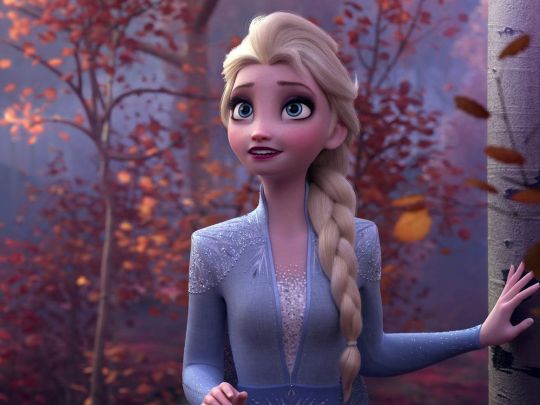
Elsa’s back. | Walt Disney Pictures
Disney used to always be looking forward. These days, it increasingly only looks back.
Nobody was more nostalgic than Marcel Proust.
The French novelist’s six-volume masterwork In Search of Lost Time is narrated by a man who’s remembering his youth, and it explores how strange and unreliable memory can be. Throughout the series, the notion of “involuntary” memory is a recurring theme, but it’s particularly important in the famous “madeleine” scene.
The scene comes early in the first volume, Swann’s Way, when the taste of a madeleine dipped in tea immediately plunges the narrator into a vivid childhood memory. It’s so well-known that it remains a cultural reference point even today, more than a century after Swann’s Way was published: To say that something is your “madeleine” is shorthand for any sensory experience that brings back a flood of childhood memories (even though mounting evidence suggests that Proust’s version may have just been soggy toast).
That sensory experiences can trigger powerful memories, particularly of youth and childhood, was not a particularly earth-shattering insight on Proust’s part — lots of people have had similar episodes. And while not all of his narrator’s recollections are fond, a lot of them seem presented through a haze of affection — the reliability of which, as the narrator us himself, is a little suspect. “Remembrance of things past is not necessarily the remembrance of things as they were,” he writes.
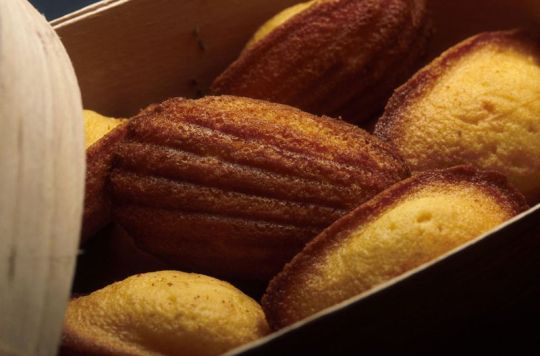
Maurice Rougemont/Gamma-Rapho/Getty Images
Marcel Proust famously wrote about madeleines as he explored the ways our memories are triggered.
Proust aptly describes the concept of nostalgia: a sentimental yearning for the past, which Merriam Webster defines, succinctly and evocatively, as “the state of being homesick.” And while we periodically recall certain moments as being worse than they actually were (I think of the 30 Rock episode in which Liz Lemon is shocked to discover that her memories of being bullied in high school are faulty, and she was the one doing the bullying), the past often takes on a rosy hue.
Time, distance, and the occasional dash of willful ignorance are effective modifiers. They’re why societies collectively hallucinate Golden Ages, and why so many people find the idea of making America “great again” appealing. It’s less about conserving the good of the past, and more about rejecting the present.
Nostalgia is not, as a mood, inherently bad. Sometimes, feeling a bit homesick is good. But when that feeling becomes our default posture, our guiding light, it starts to become ... troubling? Inhibiting, maybe? Stifling? If the past was when things were good, why bother to build a new future? Better to just keep reinventing the past.
Which brings us to Disney, and to Frozen 2.
Disney used to be a company that looked forward. These days, it seems more interested in looking back.
Disney now controls the lion’s share of the movie industry. In 2019 so far, five of the six highest-grossing films worldwide have been Disney properties; the sixth (Spider-Man: Far From Home) was a joint endeavor between Sony and Disney-owned Marvel. The company’s reach is staggering: It owns, among scores other entities, Pixar, the Marvel Cinematic Universe, Star Wars, and as of earlier this year, the film and TV assets formerly held by 21st Century Fox — in addition to its own extensive and much-beloved back catalog, lots of which is now available to stream via the just-launched Disney+ service.
Disney is in the entertainment business. But what it’s selling isn’t entertainment, exactly — that’s just the vehicle for its real product, and that product has shifted and morphed over time. At one time, a big part of what Disney was selling was a vision of a utopian future, as you know, if you’ve been to Tomorrowland or Epcot at Walt Disney World.
In his speech at the opening day of Disneyland in 1955, Walt Disney himself pointed to his vision of the park as a place where nostalgia and forward-looking inspiration could coexist: “Here age relives fond memories of the past, and here youth may savor the challenge and promise of the future.”
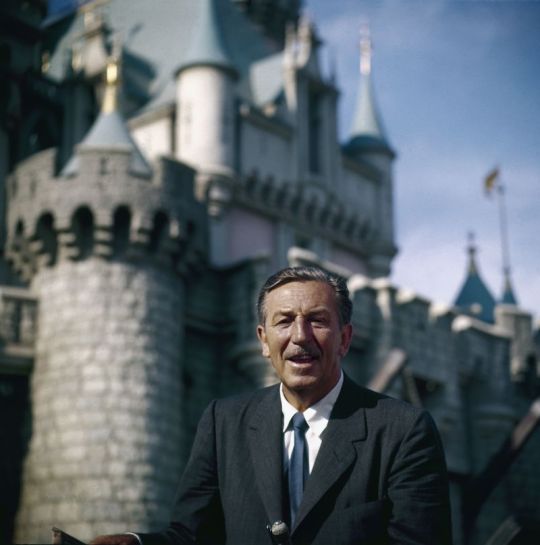
Allan Grant/The LIFE Picture Collection via Getty Images
Walt Disney at the Disneyland grand opening in 1955.
But as we come to the end of this banner year for Disney, it’s clear that what the company wants to sell us, going forward, is a seemingly infinite heap of Proustian madeleines. Certainly the warm fuzzies have been one of Disney’s main exports for a long time, but some kind of tipping point was reached in 2019. Now, it seems evident that Disney sees provoking existential homesickness as its main job. Nostalgia is its real product.
Consider Toy Story 4, the fourth film in a series that debuted in November 1995. If you were 8 years old and saw Toy Story in theaters when it opened, you might have brought your own 8-year-old to see the new film earlier this year.
That’s a remarkable stretch of time, and the Toy Story series has stayed remarkably thematically coherent over that time. It’s a set of stories about the passage of time, about how nothing stays the same, about the fact that kids grow up and leave home — that’s why Toy Story 3 left parents bawling when Andy finally grew up and didn’t need his toys anymore. The toys, in a sense, are the parents’ stand-ins. And Toy Story 4, in which some of the toys opt to live a child-free life, feels an awful lot like a movie about being an empty nester, something that could render a parent munching popcorn with their third grader a bit verklempt, thinking about their own now-empty-nester parents who once took them to see Toy Story.
That’s the good kind of nostalgia. And the Toy Story series has successfully refreshed its basic premise over two decades — toys get lost, toys get found — in part through its willingness to surprise viewers, to crack jokes and be a little creepy and think outside the (toy) box with its narratives. So when we find ourselves feeling homesick, in a story about the passage of time, it works.
I think of this approach as generative nostalgia. It’s a way for Disney to use memory, to tap into the audience’s particular madeleines, to bolster the storytelling itself (and make an enormous wad of cash, too). Not every attempt lands, but when movie studios try to tap into nostalgia in order to generate fresh new stories with universal themes, to get creative with the familiar, it’s a good thing for art.
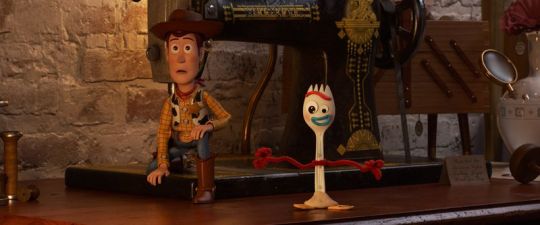
Pixar Animation Studios / Walt Disney Pictures
From Toy Story 4, we got Forky.
If Toy Story 4 was an example of Disney harnessing generative nostalgia, however, its so-called “live-action” remake of The Lion King was just the opposite. The film was never meant to be a standalone movie; its success was always fully dependent on the long-entrenched popularity of the 1994 animated film it recreates, in some cases shot for shot. It’s an entirely unnecessary movie — a way for Disney to test-drive high-end, lifelike CGI and get people to pay for it. And without the imaginative, sometimes visually wild artwork of the original, it falls very flat, with no new perspective on its source material.
Call it derivative nostalgia: For most audiences, The Lion King and Disney’s other live-action remakes (Aladdin was another huge hit this year) are interesting only insofar as they promise to deliver a (slightly) new spin on a beloved classic, without straying too far. We still get “Can You Feel the Love Tonight,” but it’s Donald Glover and Beyoncé. A copy of the original with some of the details tweaked. That’s the appeal.
And while derivative nostalgia has its place — we rewatch our favorite movies for a reason, because we like the feelings and memories they provoke — Disney seems intent on adopting it as a modus operandi, judging from the number of remakes the company has announced. It will depend on the built-in audience of people who loved Lady and the Tramp or 101 Dalmatians to pony up for a ticket or subscribe to Disney+ and ensure these projects’ success.
But I’m convinced the urge to use your giant piles of money to endlessly replicate the past can’t be good for a culture. Certainly, human culture is cumulative; we’re always building on what came before. For millennia, storytellers have leaned on the same material, like myths and archetypes, to find new ways to tell stories. But derivative nostalgia stymies the creative impulse, miring us in the same thing over and over again and training audiences to demand the predictable. Vanilla pudding tastes good, but there’s a lot more to food than vanilla pudding.
You can witness the battle for Disney’s soul happening inside Frozen 2
These generative and derivative modes of nostalgia seem to be warring inside inside Frozen 2, which is pleasing and enjoyable even if it’s clearly designed to function as an ATM for Disney, with Frozen’s previously established fanbase acting as the bank account behind the screen. It is, thank God, no Olaf’s Frozen Adventure.
The Frozen films are aimed primarily at little girls and boys, of course — Disney’s long-running core constituency for stories about princesses and talking animals (or snowmen). But, given that the first movie came out six years ago, Frozen 2 is also for older kids. And one of the most notable things about the movie is that it’s also for their parents.
Perhaps following Pixar’s lead, the more traditional Disney Animation studio has caught onto the fact that if you want grown-ups to be happy when they take kids to the movie theater, you’ve got to make something they’ll enjoy, too. So Frozen 2 leans (more noticeably than its predecessor) into jokes the adults will appreciate, and one in particular: While the kids at my screening howled at Olaf’s slapsticky misadventures, the adults were the ones laughing as Princess Anna’s hunky boyfriend Kristoff crooned his very ’80s-sounding power ballad “Lost in the Woods.”
During a recent interview, Josh Gad (who voices Olaf) joked that the song “speaks to all of us that grew up in the ’80s.” And he’s totally right. The voice of Kristoff, Jonathan Groff, says he was surprised when the song was handed to him: “I couldn’t believe that they were going to go there,” he said, calling it “truly shocking” and later saying it has the energy of Michael Bolton. The song is about how much Kristoff needs Anna in his life; in the film, he sings it during a fantasy sequence of finding her, backed by a chorus of singing reindeer. (The official Frozen 2 soundtrack includes a version of the song by Weezer, which kind of says everything.)
As Gad pointed out, it’s definitely a sight gag for the olds in the room — the younger Gen X and older millennial parents who’ve come to see Frozen 2 with their kids, and are now being rewarded with their own extended musical joke. What’s funny about it is that the musical-style “Into the Woods” parodies was already ridiculous by the time most gen-Xers and millennials became adults; what we’re reminded of now is the sheer goofiness that was so prevalent back then, when romantic ballads were sung by guys with bad hair surrounded by unironic kitsch.
Kids born in the 21st century won’t get the joke. But Frozen 2 isn’t exclusively for them; it’s for 20th-century kids, too. In fact, though its action is set just three years after the end of Frozen, it is, like Toy Story, about the passage of time, and what it’s like to grow older. Olaf sings a song about how things don’t make sense to him now, but they will someday; Anna and Olaf reflect on how they hope everything will stay the same, even though — spoiler alert — of course, they won’t.
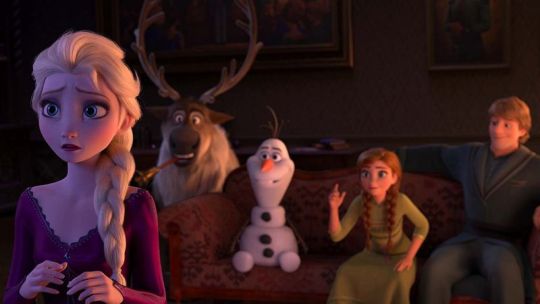
Walt Disney Pictures
The gang’s all back together in Frozen 2.
So Frozen 2 provokes all kinds of nostalgia. For kids who’ve already spent years dressing up as Anna and Elsa and driving their parents to distraction with “Let It Go,” the new film is a return to the happy land of Arendelle, where they’ve had many adventures. For teenagers who saw the original Frozen when they were 8 or so, but are now in high school, it’s a reminder of how far they’ve come. And for adults, it tugs on decades-old heartstrings — not just the chuckling memory of’ 80s power ballads, which might be the madeleine that reminds some of dancing at prom, but also the Disney princess stories so many of us grew up watching.
Whereas the original Frozen is a bit of an odd film — its plot structure feels a little out-of-sync with Disney’s usual storytelling, and its “true love’s kiss” comes not from a prince but a sister — Frozen 2 is much more conventional. Frozen retained some of the eerie strangeness of the Hans Christian Andersen fairy tale it was (very) loosely based on; Frozen 2 goes back to the usual adventure-and-return structure that has made so many classic Disney movies a success. It’s familiar. It’s comfortable.
By my lights, Frozen 2 is still a plenty enjoyable film, even if it lacks its predecessor’s subversive spark. But for me, watching generative and derivative nostalgia spar within it prompted a different sense of the familiar: bleakness about the future of mouse-eared entertainment. Disney, whatever its faults, has often been a pioneer in storytelling; now it’s resting firmly on its laurels, too often electing to spin the wheel again rather than try to reinvent it.
Nostalgia has its place. Remembering the feeling of homesickness reminds us where we came from, that we come from somewhere. But too much yearning for the past without a concomitant attempt to live in the present and push toward the future is a dangerous trap for a culture to fall into, both because it risks becoming stagnant in its art and because it may begin to to worship the past as the only place worth living in. Too much yearning for the past makes us incurious about the world. And if, as Proust wrote, the past we remember is not necessarily the one that existed, remaining stubbornly beholden to it can render us altogether incapable of dealing with the present.
The bigger Disney gets, the more it controls what most Americans — and people around the world — will see at the movies and on their TV screens, and thus it bears enormous responsibility for seeing into the future. Looking backward too much, recycling old content and relying on old formulas endlessly, becomes a snake eating its own tail.
As the endless stream of reboots and remakes and sequels and revivals that currently dominates entertainment attests, nostalgia sells. But it is also the thing most easily packaged to sell. Recycling content is the low-hanging fruit. And when Disney leans into the least creative sort of recycled content, live-action remakes — something nobody’s really asking for — it’s signaling how little it’s interested in originality.
Even when those remakes take a risk — for instance, by casting black actress Halle Bailey as Ariel in The Little Mermaid — it’s worth noting how safe the “risk” really is. Being a creative leader who celebrates inclusivity means daring to build something new, and trusting the artists to draw audiences into a new story. It doesn’t mean casting new faces in old, well-trodden roles with guaranteed built-in audiences because you’re not sure audiences will turn up otherwise. It doesn’t mean defaulting to reviving your past.
Which, ironically, is something Walt Disney was determined to keep his company from doing. As quoted in the 2007 Disney animated film Meet the Robinsons, he pushed for just the opposite: “Around here, however, we don’t look backwards for very long. We keep moving forward, opening up new doors and doing new things, because we’re curious. And curiosity keeps leading us down new paths.”
Frozen 2 opens in theaters on November 21.
from Vox - All https://ift.tt/2OvMLXf
1 note
·
View note
Text
On Frozen 2 and Disney’s nostalgia problem
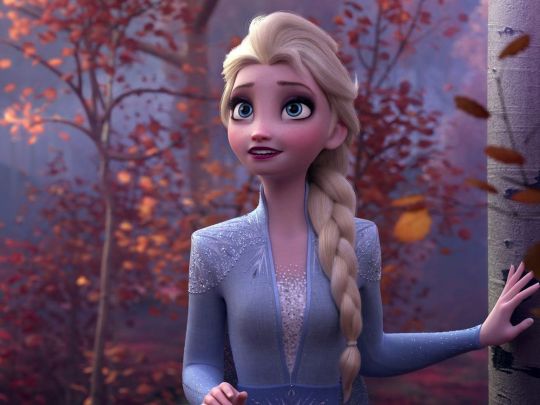
Elsa’s back. | Walt Disney Pictures
Disney used to always be looking forward. These days, it increasingly only looks back.
Nobody was more nostalgic than Marcel Proust.
The French novelist’s six-volume masterwork In Search of Lost Time is narrated by a man who’s remembering his youth, and it explores how strange and unreliable memory can be. Throughout the series, the notion of “involuntary” memory is a recurring theme, but it’s particularly important in the famous “madeleine” scene.
The scene comes early in the first volume, Swann’s Way, when the taste of a madeleine dipped in tea immediately plunges the narrator into a vivid childhood memory. It’s so well-known that it remains a cultural reference point even today, more than a century after Swann’s Way was published: To say that something is your “madeleine” is shorthand for any sensory experience that brings back a flood of childhood memories (even though mounting evidence suggests that Proust’s version may have just been soggy toast).
That sensory experiences can trigger powerful memories, particularly of youth and childhood, was not a particularly earth-shattering insight on Proust’s part — lots of people have had similar episodes. And while not all of his narrator’s recollections are fond, a lot of them seem presented through a haze of affection — the reliability of which, as the narrator us himself, is a little suspect. “Remembrance of things past is not necessarily the remembrance of things as they were,” he writes.

Maurice Rougemont/Gamma-Rapho/Getty Images
Marcel Proust famously wrote about madeleines as he explored the ways our memories are triggered.
Proust aptly describes the concept of nostalgia: a sentimental yearning for the past, which Merriam Webster defines, succinctly and evocatively, as “the state of being homesick.” And while we periodically recall certain moments as being worse than they actually were (I think of the 30 Rock episode in which Liz Lemon is shocked to discover that her memories of being bullied in high school are faulty, and she was the one doing the bullying), the past often takes on a rosy hue.
Time, distance, and the occasional dash of willful ignorance are effective modifiers. They’re why societies collectively hallucinate Golden Ages, and why so many people find the idea of making America “great again” appealing. It’s less about conserving the good of the past, and more about rejecting the present.
Nostalgia is not, as a mood, inherently bad. Sometimes, feeling a bit homesick is good. But when that feeling becomes our default posture, our guiding light, it starts to become ... troubling? Inhibiting, maybe? Stifling? If the past was when things were good, why bother to build a new future? Better to just keep reinventing the past.
Which brings us to Disney, and to Frozen 2.
Disney used to be a company that looked forward. These days, it seems more interested in looking back.
Disney now controls the lion’s share of the movie industry. In 2019 so far, five of the six highest-grossing films worldwide have been Disney properties; the sixth (Spider-Man: Far From Home) was a joint endeavor between Sony and Disney-owned Marvel. The company’s reach is staggering: It owns, among scores other entities, Pixar, the Marvel Cinematic Universe, Star Wars, and as of earlier this year, the film and TV assets formerly held by 21st Century Fox — in addition to its own extensive and much-beloved back catalog, lots of which is now available to stream via the just-launched Disney+ service.
Disney is in the entertainment business. But what it’s selling isn’t entertainment, exactly — that’s just the vehicle for its real product, and that product has shifted and morphed over time. At one time, a big part of what Disney was selling was a vision of a utopian future, as you know, if you’ve been to Tomorrowland or Epcot at Walt Disney World.
In his speech at the opening day of Disneyland in 1955, Walt Disney himself pointed to his vision of the park as a place where nostalgia and forward-looking inspiration could coexist: “Here age relives fond memories of the past, and here youth may savor the challenge and promise of the future.”
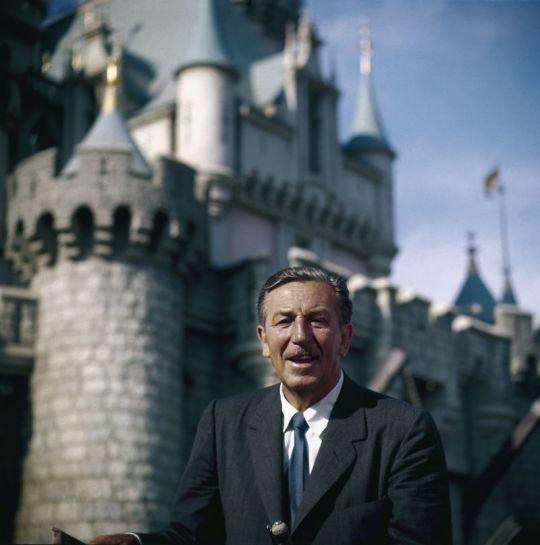
Allan Grant/The LIFE Picture Collection via Getty Images
Walt Disney at the Disneyland grand opening in 1955.
But as we come to the end of this banner year for Disney, it’s clear that what the company wants to sell us, going forward, is a seemingly infinite heap of Proustian madeleines. Certainly the warm fuzzies have been one of Disney’s main exports for a long time, but some kind of tipping point was reached in 2019. Now, it seems evident that Disney sees provoking existential homesickness as its main job. Nostalgia is its real product.
Consider Toy Story 4, the fourth film in a series that debuted in November 1995. If you were 8 years old and saw Toy Story in theaters when it opened, you might have brought your own 8-year-old to see the new film earlier this year.
That’s a remarkable stretch of time, and the Toy Story series has stayed remarkably thematically coherent over that time. It’s a set of stories about the passage of time, about how nothing stays the same, about the fact that kids grow up and leave home — that’s why Toy Story 3 left parents bawling when Andy finally grew up and didn’t need his toys anymore. The toys, in a sense, are the parents’ stand-ins. And Toy Story 4, in which some of the toys opt to live a child-free life, feels an awful lot like a movie about being an empty nester, something that could render a parent munching popcorn with their third grader a bit verklempt, thinking about their own now-empty-nester parents who once took them to see Toy Story.
That’s the good kind of nostalgia. And the Toy Story series has successfully refreshed its basic premise over two decades — toys get lost, toys get found — in part through its willingness to surprise viewers, to crack jokes and be a little creepy and think outside the (toy) box with its narratives. So when we find ourselves feeling homesick, in a story about the passage of time, it works.
I think of this approach as generative nostalgia. It’s a way for Disney to use memory, to tap into the audience’s particular madeleines, to bolster the storytelling itself (and make an enormous wad of cash, too). Not every attempt lands, but when movie studios try to tap into nostalgia in order to generate fresh new stories with universal themes, to get creative with the familiar, it’s a good thing for art.
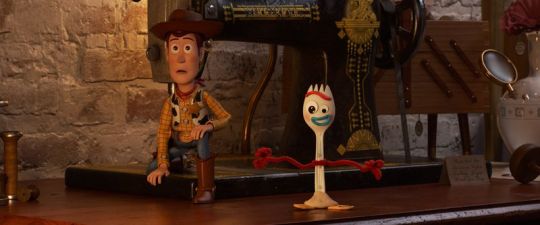
Pixar Animation Studios / Walt Disney Pictures
From Toy Story 4, we got Forky.
If Toy Story 4 was an example of Disney harnessing generative nostalgia, however, its so-called “live-action” remake of The Lion King was just the opposite. The film was never meant to be a standalone movie; its success was always fully dependent on the long-entrenched popularity of the 1994 animated film it recreates, in some cases shot for shot. It’s an entirely unnecessary movie — a way for Disney to test-drive high-end, lifelike CGI and get people to pay for it. And without the imaginative, sometimes visually wild artwork of the original, it falls very flat, with no new perspective on its source material.
Call it derivative nostalgia: For most audiences, The Lion King and Disney’s other live-action remakes (Aladdin was another huge hit this year) are interesting only insofar as they promise to deliver a (slightly) new spin on a beloved classic, without straying too far. We still get “Can You Feel the Love Tonight,” but it’s Donald Glover and Beyoncé. A copy of the original with some of the details tweaked. That’s the appeal.
And while derivative nostalgia has its place — we rewatch our favorite movies for a reason, because we like the feelings and memories they provoke — Disney seems intent on adopting it as a modus operandi, judging from the number of remakes the company has announced. It will depend on the built-in audience of people who loved Lady and the Tramp or 101 Dalmatians to pony up for a ticket or subscribe to Disney+ and ensure these projects’ success.
But I’m convinced the urge to use your giant piles of money to endlessly replicate the past can’t be good for a culture. Certainly, human culture is cumulative; we’re always building on what came before. For millennia, storytellers have leaned on the same material, like myths and archetypes, to find new ways to tell stories. But derivative nostalgia stymies the creative impulse, miring us in the same thing over and over again and training audiences to demand the predictable. Vanilla pudding tastes good, but there’s a lot more to food than vanilla pudding.
You can witness the battle for Disney’s soul happening inside Frozen 2
These generative and derivative modes of nostalgia seem to be warring inside inside Frozen 2, which is pleasing and enjoyable even if it’s clearly designed to function as an ATM for Disney, with Frozen’s previously established fanbase acting as the bank account behind the screen. It is, thank God, no Olaf’s Frozen Adventure.
The Frozen films are aimed primarily at little girls and boys, of course — Disney’s long-running core constituency for stories about princesses and talking animals (or snowmen). But, given that the first movie came out six years ago, Frozen 2 is also for older kids. And one of the most notable things about the movie is that it’s also for their parents.
Perhaps following Pixar’s lead, the more traditional Disney Animation studio has caught onto the fact that if you want grown-ups to be happy when they take kids to the movie theater, you’ve got to make something they’ll enjoy, too. So Frozen 2 leans (more noticeably than its predecessor) into jokes the adults will appreciate, and one in particular: While the kids at my screening howled at Olaf’s slapsticky misadventures, the adults were the ones laughing as Princess Anna’s hunky boyfriend Kristoff crooned his very ’80s-sounding power ballad “Lost in the Woods.”
During a recent interview, Josh Gad (who voices Olaf) joked that the song “speaks to all of us that grew up in the ’80s.” And he’s totally right. The voice of Kristoff, Jonathan Groff, says he was surprised when the song was handed to him: “I couldn’t believe that they were going to go there,” he said, calling it “truly shocking” and later saying it has the energy of Michael Bolton. The song is about how much Kristoff needs Anna in his life; in the film, he sings it during a fantasy sequence of finding her, backed by a chorus of singing reindeer. (The official Frozen 2 soundtrack includes a version of the song by Weezer, which kind of says everything.)
As Gad pointed out, it’s definitely a sight gag for the olds in the room — the younger Gen X and older millennial parents who’ve come to see Frozen 2 with their kids, and are now being rewarded with their own extended musical joke. What’s funny about it is that the musical-style “Into the Woods” parodies was already ridiculous by the time most gen-Xers and millennials became adults; what we’re reminded of now is the sheer goofiness that was so prevalent back then, when romantic ballads were sung by guys with bad hair surrounded by unironic kitsch.
Kids born in the 21st century won’t get the joke. But Frozen 2 isn’t exclusively for them; it’s for 20th-century kids, too. In fact, though its action is set just three years after the end of Frozen, it is, like Toy Story, about the passage of time, and what it’s like to grow older. Olaf sings a song about how things don’t make sense to him now, but they will someday; Anna and Olaf reflect on how they hope everything will stay the same, even though — spoiler alert — of course, they won’t.
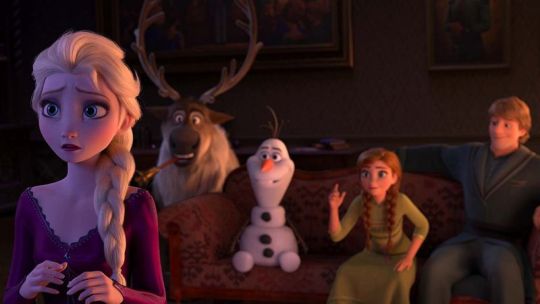
Walt Disney Pictures
The gang’s all back together in Frozen 2.
So Frozen 2 provokes all kinds of nostalgia. For kids who’ve already spent years dressing up as Anna and Elsa and driving their parents to distraction with “Let It Go,” the new film is a return to the happy land of Arendelle, where they’ve had many adventures. For teenagers who saw the original Frozen when they were 8 or so, but are now in high school, it’s a reminder of how far they’ve come. And for adults, it tugs on decades-old heartstrings — not just the chuckling memory of’ 80s power ballads, which might be the madeleine that reminds some of dancing at prom, but also the Disney princess stories so many of us grew up watching.
Whereas the original Frozen is a bit of an odd film — its plot structure feels a little out-of-sync with Disney’s usual storytelling, and its “true love’s kiss” comes not from a prince but a sister — Frozen 2 is much more conventional. Frozen retained some of the eerie strangeness of the Hans Christian Andersen fairy tale it was (very) loosely based on; Frozen 2 goes back to the usual adventure-and-return structure that has made so many classic Disney movies a success. It’s familiar. It’s comfortable.
By my lights, Frozen 2 is still a plenty enjoyable film, even if it lacks its predecessor’s subversive spark. But for me, watching generative and derivative nostalgia spar within it prompted a different sense of the familiar: bleakness about the future of mouse-eared entertainment. Disney, whatever its faults, has often been a pioneer in storytelling; now it’s resting firmly on its laurels, too often electing to spin the wheel again rather than try to reinvent it.
Nostalgia has its place. Remembering the feeling of homesickness reminds us where we came from, that we come from somewhere. But too much yearning for the past without a concomitant attempt to live in the present and push toward the future is a dangerous trap for a culture to fall into, both because it risks becoming stagnant in its art and because it may begin to to worship the past as the only place worth living in. Too much yearning for the past makes us incurious about the world. And if, as Proust wrote, the past we remember is not necessarily the one that existed, remaining stubbornly beholden to it can render us altogether incapable of dealing with the present.
The bigger Disney gets, the more it controls what most Americans — and people around the world — will see at the movies and on their TV screens, and thus it bears enormous responsibility for seeing into the future. Looking backward too much, recycling old content and relying on old formulas endlessly, becomes a snake eating its own tail.
As the endless stream of reboots and remakes and sequels and revivals that currently dominates entertainment attests, nostalgia sells. But it is also the thing most easily packaged to sell. Recycling content is the low-hanging fruit. And when Disney leans into the least creative sort of recycled content, live-action remakes — something nobody’s really asking for — it’s signaling how little it’s interested in originality.
Even when those remakes take a risk — for instance, by casting black actress Halle Bailey as Ariel in The Little Mermaid — it’s worth noting how safe the “risk” really is. Being a creative leader who celebrates inclusivity means daring to build something new, and trusting the artists to draw audiences into a new story. It doesn’t mean casting new faces in old, well-trodden roles with guaranteed built-in audiences because you’re not sure audiences will turn up otherwise. It doesn’t mean defaulting to reviving your past.
Which, ironically, is something Walt Disney was determined to keep his company from doing. As quoted in the 2007 Disney animated film Meet the Robinsons, he pushed for just the opposite: “Around here, however, we don’t look backwards for very long. We keep moving forward, opening up new doors and doing new things, because we’re curious. And curiosity keeps leading us down new paths.”
Frozen 2 opens in theaters on November 21.
from Vox - All https://ift.tt/2OvMLXf
0 notes
Text
On Frozen 2 and Disney’s nostalgia problem
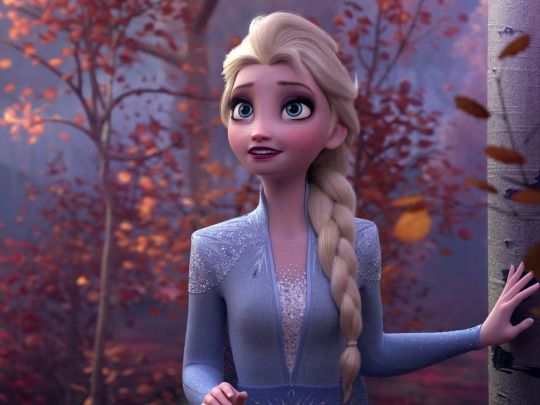
Elsa’s back. | Walt Disney Pictures
Disney used to always be looking forward. These days, it increasingly only looks back.
Nobody was more nostalgic than Marcel Proust.
The French novelist’s six-volume masterwork In Search of Lost Time is narrated by a man who’s remembering his youth, and it explores how strange and unreliable memory can be. Throughout the series, the notion of “involuntary” memory is a recurring theme, but it’s particularly important in the famous “madeleine” scene.
The scene comes early in the first volume, Swann’s Way, when the taste of a madeleine dipped in tea immediately plunges the narrator into a vivid childhood memory. It’s so well-known that it remains a cultural reference point even today, more than a century after Swann’s Way was published: To say that something is your “madeleine” is shorthand for any sensory experience that brings back a flood of childhood memories (even though mounting evidence suggests that Proust’s version may have just been soggy toast).
That sensory experiences can trigger powerful memories, particularly of youth and childhood, was not a particularly earth-shattering insight on Proust’s part — lots of people have had similar episodes. And while not all of his narrator’s recollections are fond, a lot of them seem presented through a haze of affection — the reliability of which, as the narrator us himself, is a little suspect. “Remembrance of things past is not necessarily the remembrance of things as they were,” he writes.

Maurice Rougemont/Gamma-Rapho/Getty Images
Marcel Proust famously wrote about madeleines as he explored the ways our memories are triggered.
Proust aptly describes the concept of nostalgia: a sentimental yearning for the past, which Merriam Webster defines, succinctly and evocatively, as “the state of being homesick.” And while we periodically recall certain moments as being worse than they actually were (I think of the 30 Rock episode in which Liz Lemon is shocked to discover that her memories of being bullied in high school are faulty, and she was the one doing the bullying), the past often takes on a rosy hue.
Time, distance, and the occasional dash of willful ignorance are effective modifiers. They’re why societies collectively hallucinate Golden Ages, and why so many people find the idea of making America “great again” appealing. It’s less about conserving the good of the past, and more about rejecting the present.
Nostalgia is not, as a mood, inherently bad. Sometimes, feeling a bit homesick is good. But when that feeling becomes our default posture, our guiding light, it starts to become ... troubling? Inhibiting, maybe? Stifling? If the past was when things were good, why bother to build a new future? Better to just keep reinventing the past.
Which brings us to Disney, and to Frozen 2.
Disney used to be a company that looked forward. These days, it seems more interested in looking back.
Disney now controls the lion’s share of the movie industry. In 2019 so far, five of the six highest-grossing films worldwide have been Disney properties; the sixth (Spider-Man: Far From Home) was a joint endeavor between Sony and Disney-owned Marvel. The company’s reach is staggering: It owns, among scores other entities, Pixar, the Marvel Cinematic Universe, Star Wars, and as of earlier this year, the film and TV assets formerly held by 21st Century Fox — in addition to its own extensive and much-beloved back catalog, lots of which is now available to stream via the just-launched Disney+ service.
Disney is in the entertainment business. But what it’s selling isn’t entertainment, exactly — that’s just the vehicle for its real product, and that product has shifted and morphed over time. At one time, a big part of what Disney was selling was a vision of a utopian future, as you know, if you’ve been to Tomorrowland or Epcot at Walt Disney World.
In his speech at the opening day of Disneyland in 1955, Walt Disney himself pointed to his vision of the park as a place where nostalgia and forward-looking inspiration could coexist: “Here age relives fond memories of the past, and here youth may savor the challenge and promise of the future.”
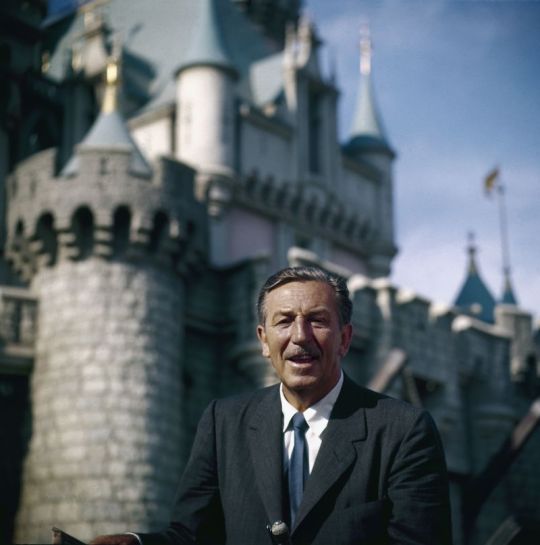
Allan Grant/The LIFE Picture Collection via Getty Images
Walt Disney at the Disneyland grand opening in 1955.
But as we come to the end of this banner year for Disney, it’s clear that what the company wants to sell us, going forward, is a seemingly infinite heap of Proustian madeleines. Certainly the warm fuzzies have been one of Disney’s main exports for a long time, but some kind of tipping point was reached in 2019. Now, it seems evident that Disney sees provoking existential homesickness as its main job. Nostalgia is its real product.
Consider Toy Story 4, the fourth film in a series that debuted in November 1995. If you were 8 years old and saw Toy Story in theaters when it opened, you might have brought your own 8-year-old to see the new film earlier this year.
That’s a remarkable stretch of time, and the Toy Story series has stayed remarkably thematically coherent over that time. It’s a set of stories about the passage of time, about how nothing stays the same, about the fact that kids grow up and leave home — that’s why Toy Story 3 left parents bawling when Andy finally grew up and didn’t need his toys anymore. The toys, in a sense, are the parents’ stand-ins. And Toy Story 4, in which some of the toys opt to live a child-free life, feels an awful lot like a movie about being an empty nester, something that could render a parent munching popcorn with their third grader a bit verklempt, thinking about their own now-empty-nester parents who once took them to see Toy Story.
That’s the good kind of nostalgia. And the Toy Story series has successfully refreshed its basic premise over two decades — toys get lost, toys get found — in part through its willingness to surprise viewers, to crack jokes and be a little creepy and think outside the (toy) box with its narratives. So when we find ourselves feeling homesick, in a story about the passage of time, it works.
I think of this approach as generative nostalgia. It’s a way for Disney to use memory, to tap into the audience’s particular madeleines, to bolster the storytelling itself (and make an enormous wad of cash, too). Not every attempt lands, but when movie studios try to tap into nostalgia in order to generate fresh new stories with universal themes, to get creative with the familiar, it’s a good thing for art.
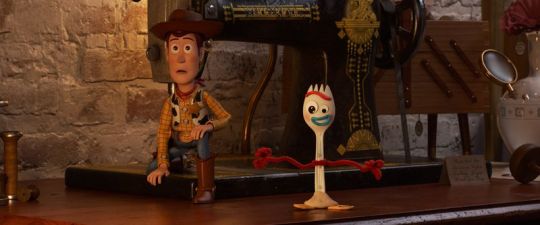
Pixar Animation Studios / Walt Disney Pictures
From Toy Story 4, we got Forky.
If Toy Story 4 was an example of Disney harnessing generative nostalgia, however, its so-called “live-action” remake of The Lion King was just the opposite. The film was never meant to be a standalone movie; its success was always fully dependent on the long-entrenched popularity of the 1994 animated film it recreates, in some cases shot for shot. It’s an entirely unnecessary movie — a way for Disney to test-drive high-end, lifelike CGI and get people to pay for it. And without the imaginative, sometimes visually wild artwork of the original, it falls very flat, with no new perspective on its source material.
Call it derivative nostalgia: For most audiences, The Lion King and Disney’s other live-action remakes (Aladdin was another huge hit this year) are interesting only insofar as they promise to deliver a (slightly) new spin on a beloved classic, without straying too far. We still get “Can You Feel the Love Tonight,” but it’s Donald Glover and Beyoncé. A copy of the original with some of the details tweaked. That’s the appeal.
And while derivative nostalgia has its place — we rewatch our favorite movies for a reason, because we like the feelings and memories they provoke — Disney seems intent on adopting it as a modus operandi, judging from the number of remakes the company has announced. It will depend on the built-in audience of people who loved Lady and the Tramp or 101 Dalmatians to pony up for a ticket or subscribe to Disney+ and ensure these projects’ success.
But I’m convinced the urge to use your giant piles of money to endlessly replicate the past can’t be good for a culture. Certainly, human culture is cumulative; we’re always building on what came before. For millennia, storytellers have leaned on the same material, like myths and archetypes, to find new ways to tell stories. But derivative nostalgia stymies the creative impulse, miring us in the same thing over and over again and training audiences to demand the predictable. Vanilla pudding tastes good, but there’s a lot more to food than vanilla pudding.
You can witness the battle for Disney’s soul happening inside Frozen 2
These generative and derivative modes of nostalgia seem to be warring inside inside Frozen 2, which is pleasing and enjoyable even if it’s clearly designed to function as an ATM for Disney, with Frozen’s previously established fanbase acting as the bank account behind the screen. It is, thank God, no Olaf’s Frozen Adventure.
The Frozen films are aimed primarily at little girls and boys, of course — Disney’s long-running core constituency for stories about princesses and talking animals (or snowmen). But, given that the first movie came out six years ago, Frozen 2 is also for older kids. And one of the most notable things about the movie is that it’s also for their parents.
Perhaps following Pixar’s lead, the more traditional Disney Animation studio has caught onto the fact that if you want grown-ups to be happy when they take kids to the movie theater, you’ve got to make something they’ll enjoy, too. So Frozen 2 leans (more noticeably than its predecessor) into jokes the adults will appreciate, and one in particular: While the kids at my screening howled at Olaf’s slapsticky misadventures, the adults were the ones laughing as Princess Anna’s hunky boyfriend Kristoff crooned his very ’80s-sounding power ballad “Lost in the Woods.”
During a recent interview, Josh Gad (who voices Olaf) joked that the song “speaks to all of us that grew up in the ’80s.” And he’s totally right. The voice of Kristoff, Jonathan Groff, says he was surprised when the song was handed to him: “I couldn’t believe that they were going to go there,” he said, calling it “truly shocking” and later saying it has the energy of Michael Bolton. The song is about how much Kristoff needs Anna in his life; in the film, he sings it during a fantasy sequence of finding her, backed by a chorus of singing reindeer. (The official Frozen 2 soundtrack includes a version of the song by Weezer, which kind of says everything.)
As Gad pointed out, it’s definitely a sight gag for the olds in the room — the younger Gen X and older millennial parents who’ve come to see Frozen 2 with their kids, and are now being rewarded with their own extended musical joke. What’s funny about it is that the musical-style “Into the Woods” parodies was already ridiculous by the time most gen-Xers and millennials became adults; what we’re reminded of now is the sheer goofiness that was so prevalent back then, when romantic ballads were sung by guys with bad hair surrounded by unironic kitsch.
Kids born in the 21st century won’t get the joke. But Frozen 2 isn’t exclusively for them; it’s for 20th-century kids, too. In fact, though its action is set just three years after the end of Frozen, it is, like Toy Story, about the passage of time, and what it’s like to grow older. Olaf sings a song about how things don’t make sense to him now, but they will someday; Anna and Olaf reflect on how they hope everything will stay the same, even though — spoiler alert — of course, they won’t.
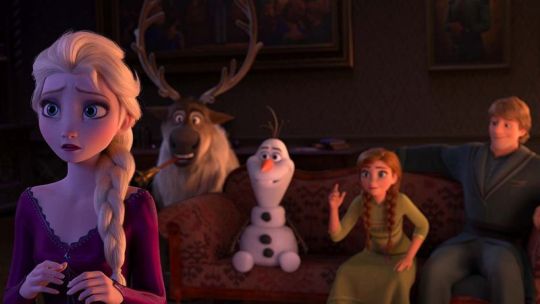
Walt Disney Pictures
The gang’s all back together in Frozen 2.
So Frozen 2 provokes all kinds of nostalgia. For kids who’ve already spent years dressing up as Anna and Elsa and driving their parents to distraction with “Let It Go,” the new film is a return to the happy land of Arendelle, where they’ve had many adventures. For teenagers who saw the original Frozen when they were 8 or so, but are now in high school, it’s a reminder of how far they’ve come. And for adults, it tugs on decades-old heartstrings — not just the chuckling memory of’ 80s power ballads, which might be the madeleine that reminds some of dancing at prom, but also the Disney princess stories so many of us grew up watching.
Whereas the original Frozen is a bit of an odd film — its plot structure feels a little out-of-sync with Disney’s usual storytelling, and its “true love’s kiss” comes not from a prince but a sister — Frozen 2 is much more conventional. Frozen retained some of the eerie strangeness of the Hans Christian Andersen fairy tale it was (very) loosely based on; Frozen 2 goes back to the usual adventure-and-return structure that has made so many classic Disney movies a success. It’s familiar. It’s comfortable.
By my lights, Frozen 2 is still a plenty enjoyable film, even if it lacks its predecessor’s subversive spark. But for me, watching generative and derivative nostalgia spar within it prompted a different sense of the familiar: bleakness about the future of mouse-eared entertainment. Disney, whatever its faults, has often been a pioneer in storytelling; now it’s resting firmly on its laurels, too often electing to spin the wheel again rather than try to reinvent it.
Nostalgia has its place. Remembering the feeling of homesickness reminds us where we came from, that we come from somewhere. But too much yearning for the past without a concomitant attempt to live in the present and push toward the future is a dangerous trap for a culture to fall into, both because it risks becoming stagnant in its art and because it may begin to to worship the past as the only place worth living in. Too much yearning for the past makes us incurious about the world. And if, as Proust wrote, the past we remember is not necessarily the one that existed, remaining stubbornly beholden to it can render us altogether incapable of dealing with the present.
The bigger Disney gets, the more it controls what most Americans — and people around the world — will see at the movies and on their TV screens, and thus it bears enormous responsibility for seeing into the future. Looking backward too much, recycling old content and relying on old formulas endlessly, becomes a snake eating its own tail.
As the endless stream of reboots and remakes and sequels and revivals that currently dominates entertainment attests, nostalgia sells. But it is also the thing most easily packaged to sell. Recycling content is the low-hanging fruit. And when Disney leans into the least creative sort of recycled content, live-action remakes — something nobody’s really asking for — it’s signaling how little it’s interested in originality.
Even when those remakes take a risk — for instance, by casting black actress Halle Bailey as Ariel in The Little Mermaid — it’s worth noting how safe the “risk” really is. Being a creative leader who celebrates inclusivity means daring to build something new, and trusting the artists to draw audiences into a new story. It doesn’t mean casting new faces in old, well-trodden roles with guaranteed built-in audiences because you’re not sure audiences will turn up otherwise. It doesn’t mean defaulting to reviving your past.
Which, ironically, is something Walt Disney was determined to keep his company from doing. As quoted in the 2007 Disney animated film Meet the Robinsons, he pushed for just the opposite: “Around here, however, we don’t look backwards for very long. We keep moving forward, opening up new doors and doing new things, because we’re curious. And curiosity keeps leading us down new paths.”
Frozen 2 opens in theaters on November 21.
from Vox - All https://ift.tt/2OvMLXf
0 notes
Text
On Frozen 2 and Disney’s nostalgia problem
Elsa’s back. | Walt Disney Pictures
Disney used to always be looking forward. These days, it increasingly only looks back.
Nobody was more nostalgic than Marcel Proust.
The French novelist’s six-volume masterwork In Search of Lost Time is narrated by a man who’s remembering his youth, and it explores how strange and unreliable memory can be. Throughout the series, the notion of “involuntary” memory is a recurring theme, but it’s particularly important in the famous “madeleine” scene.
The scene comes early in the first volume, Swann’s Way, when the taste of a madeleine dipped in tea immediately plunges the narrator into a vivid childhood memory. It’s so well-known that it remains a cultural reference point even today, more than a century after Swann’s Way was published: To say that something is your “madeleine” is shorthand for any sensory experience that brings back a flood of childhood memories (even though mounting evidence suggests that Proust’s version may have just been soggy toast).
That sensory experiences can trigger powerful memories, particularly of youth and childhood, was not a particularly earth-shattering insight on Proust’s part — lots of people have had similar episodes. And while not all of his narrator’s recollections are fond, a lot of them seem presented through a haze of affection — the reliability of which, as the narrator us himself, is a little suspect. “Remembrance of things past is not necessarily the remembrance of things as they were,” he writes.
Maurice Rougemont/Gamma-Rapho/Getty Images
Marcel Proust famously wrote about madeleines as he explored the ways our memories are triggered.
Proust aptly describes the concept of nostalgia: a sentimental yearning for the past, which Merriam Webster defines, succinctly and evocatively, as “the state of being homesick.” And while we periodically recall certain moments as being worse than they actually were (I think of the 30 Rock episode in which Liz Lemon is shocked to discover that her memories of being bullied in high school are faulty, and she was the one doing the bullying), the past often takes on a rosy hue.
Time, distance, and the occasional dash of willful ignorance are effective modifiers. They’re why societies collectively hallucinate Golden Ages, and why so many people find the idea of making America “great again” appealing. It’s less about conserving the good of the past, and more about rejecting the present.
Nostalgia is not, as a mood, inherently bad. Sometimes, feeling a bit homesick is good. But when that feeling becomes our default posture, our guiding light, it starts to become ... troubling? Inhibiting, maybe? Stifling? If the past was when things were good, why bother to build a new future? Better to just keep reinventing the past.
Which brings us to Disney, and to Frozen 2.
Disney used to be a company that looked forward. These days, it seems more interested in looking back.
Disney now controls the lion’s share of the movie industry. In 2019 so far, five of the six highest-grossing films worldwide have been Disney properties; the sixth (Spider-Man: Far From Home) was a joint endeavor between Sony and Disney-owned Marvel. The company’s reach is staggering: It owns, among scores other entities, Pixar, the Marvel Cinematic Universe, Star Wars, and as of earlier this year, the film and TV assets formerly held by 21st Century Fox — in addition to its own extensive and much-beloved back catalog, lots of which is now available to stream via the just-launched Disney+ service.
Disney is in the entertainment business. But what it’s selling isn’t entertainment, exactly — that’s just the vehicle for its real product, and that product has shifted and morphed over time. At one time, a big part of what Disney was selling was a vision of a utopian future, as you know, if you’ve been to Tomorrowland or Epcot at Walt Disney World.
In his speech at the opening day of Disneyland in 1955, Walt Disney himself pointed to his vision of the park as a place where nostalgia and forward-looking inspiration could coexist: “Here age relives fond memories of the past, and here youth may savor the challenge and promise of the future.”
Allan Grant/The LIFE Picture Collection via Getty Images
Walt Disney at the Disneyland grand opening in 1955.
But as we come to the end of this banner year for Disney, it’s clear that what the company wants to sell us, going forward, is a seemingly infinite heap of Proustian madeleines. Certainly the warm fuzzies have been one of Disney’s main exports for a long time, but some kind of tipping point was reached in 2019. Now, it seems evident that Disney sees provoking existential homesickness as its main job. Nostalgia is its real product.
Consider Toy Story 4, the fourth film in a series that debuted in November 1995. If you were 8 years old and saw Toy Story in theaters when it opened, you might have brought your own 8-year-old to see the new film earlier this year.
That’s a remarkable stretch of time, and the Toy Story series has stayed remarkably thematically coherent over that time. It’s a set of stories about the passage of time, about how nothing stays the same, about the fact that kids grow up and leave home — that’s why Toy Story 3 left parents bawling when Andy finally grew up and didn’t need his toys anymore. The toys, in a sense, are the parents’ stand-ins. And Toy Story 4, in which some of the toys opt to live a child-free life, feels an awful lot like a movie about being an empty nester, something that could render a parent munching popcorn with their third grader a bit verklempt, thinking about their own now-empty-nester parents who once took them to see Toy Story.
That’s the good kind of nostalgia. And the Toy Story series has successfully refreshed its basic premise over two decades — toys get lost, toys get found — in part through its willingness to surprise viewers, to crack jokes and be a little creepy and think outside the (toy) box with its narratives. So when we find ourselves feeling homesick, in a story about the passage of time, it works.
I think of this approach as generative nostalgia. It’s a way for Disney to use memory, to tap into the audience’s particular madeleines, to bolster the storytelling itself (and make an enormous wad of cash, too). Not every attempt lands, but when movie studios try to tap into nostalgia in order to generate fresh new stories with universal themes, to get creative with the familiar, it’s a good thing for art.
Pixar Animation Studios / Walt Disney Pictures
From Toy Story 4, we got Forky.
If Toy Story 4 was an example of Disney harnessing generative nostalgia, however, its so-called “live-action” remake of The Lion King was just the opposite. The film was never meant to be a standalone movie; its success was always fully dependent on the long-entrenched popularity of the 1994 animated film it recreates, in some cases shot for shot. It’s an entirely unnecessary movie — a way for Disney to test-drive high-end, lifelike CGI and get people to pay for it. And without the imaginative, sometimes visually wild artwork of the original, it falls very flat, with no new perspective on its source material.
Call it derivative nostalgia: For most audiences, The Lion King and Disney’s other live-action remakes (Aladdin was another huge hit this year) are interesting only insofar as they promise to deliver a (slightly) new spin on a beloved classic, without straying too far. We still get “Can You Feel the Love Tonight,” but it’s Donald Glover and Beyoncé. A copy of the original with some of the details tweaked. That’s the appeal.
And while derivative nostalgia has its place — we rewatch our favorite movies for a reason, because we like the feelings and memories they provoke — Disney seems intent on adopting it as a modus operandi, judging from the number of remakes the company has announced. It will depend on the built-in audience of people who loved Lady and the Tramp or 101 Dalmatians to pony up for a ticket or subscribe to Disney+ and ensure these projects’ success.
But I’m convinced the urge to use your giant piles of money to endlessly replicate the past can’t be good for a culture. Certainly, human culture is cumulative; we’re always building on what came before. For millennia, storytellers have leaned on the same material, like myths and archetypes, to find new ways to tell stories. But derivative nostalgia stymies the creative impulse, miring us in the same thing over and over again and training audiences to demand the predictable. Vanilla pudding tastes good, but there’s a lot more to food than vanilla pudding.
You can witness the battle for Disney’s soul happening inside Frozen 2
These generative and derivative modes of nostalgia seem to be warring inside inside Frozen 2, which is pleasing and enjoyable even if it’s clearly designed to function as an ATM for Disney, with Frozen’s previously established fanbase acting as the bank account behind the screen. It is, thank God, no Olaf’s Frozen Adventure.
The Frozen films are aimed primarily at little girls and boys, of course — Disney’s long-running core constituency for stories about princesses and talking animals (or snowmen). But, given that the first movie came out six years ago, Frozen 2 is also for older kids. And one of the most notable things about the movie is that it’s also for their parents.
Perhaps following Pixar’s lead, the more traditional Disney Animation studio has caught onto the fact that if you want grown-ups to be happy when they take kids to the movie theater, you’ve got to make something they’ll enjoy, too. So Frozen 2 leans (more noticeably than its predecessor) into jokes the adults will appreciate, and one in particular: While the kids at my screening howled at Olaf’s slapsticky misadventures, the adults were the ones laughing as Princess Anna’s hunky boyfriend Kristoff crooned his very ’80s-sounding power ballad “Lost in the Woods.”
During a recent interview, Josh Gad (who voices Olaf) joked that the song “speaks to all of us that grew up in the ’80s.” And he’s totally right. The voice of Kristoff, Jonathan Groff, says he was surprised when the song was handed to him: “I couldn’t believe that they were going to go there,” he said, calling it “truly shocking” and later saying it has the energy of Michael Bolton. The song is about how much Kristoff needs Anna in his life; in the film, he sings it during a fantasy sequence of finding her, backed by a chorus of singing reindeer. (The official Frozen 2 soundtrack includes a version of the song by Weezer, which kind of says everything.)
As Gad pointed out, it’s definitely a sight gag for the olds in the room — the younger Gen X and older millennial parents who’ve come to see Frozen 2 with their kids, and are now being rewarded with their own extended musical joke. What’s funny about it is that the musical-style “Into the Woods” parodies was already ridiculous by the time most gen-Xers and millennials became adults; what we’re reminded of now is the sheer goofiness that was so prevalent back then, when romantic ballads were sung by guys with bad hair surrounded by unironic kitsch.
Kids born in the 21st century won’t get the joke. But Frozen 2 isn’t exclusively for them; it’s for 20th-century kids, too. In fact, though its action is set just three years after the end of Frozen, it is, like Toy Story, about the passage of time, and what it’s like to grow older. Olaf sings a song about how things don’t make sense to him now, but they will someday; Anna and Olaf reflect on how they hope everything will stay the same, even though — spoiler alert — of course, they won’t.
Walt Disney Pictures
The gang’s all back together in Frozen 2.
So Frozen 2 provokes all kinds of nostalgia. For kids who’ve already spent years dressing up as Anna and Elsa and driving their parents to distraction with “Let It Go,” the new film is a return to the happy land of Arendelle, where they’ve had many adventures. For teenagers who saw the original Frozen when they were 8 or so, but are now in high school, it’s a reminder of how far they’ve come. And for adults, it tugs on decades-old heartstrings — not just the chuckling memory of’ 80s power ballads, which might be the madeleine that reminds some of dancing at prom, but also the Disney princess stories so many of us grew up watching.
Whereas the original Frozen is a bit of an odd film — its plot structure feels a little out-of-sync with Disney’s usual storytelling, and its “true love’s kiss” comes not from a prince but a sister — Frozen 2 is much more conventional. Frozen retained some of the eerie strangeness of the Hans Christian Andersen fairy tale it was (very) loosely based on; Frozen 2 goes back to the usual adventure-and-return structure that has made so many classic Disney movies a success. It’s familiar. It’s comfortable.
By my lights, Frozen 2 is still a plenty enjoyable film, even if it lacks its predecessor’s subversive spark. But for me, watching generative and derivative nostalgia spar within it prompted a different sense of the familiar: bleakness about the future of mouse-eared entertainment. Disney, whatever its faults, has often been a pioneer in storytelling; now it’s resting firmly on its laurels, too often electing to spin the wheel again rather than try to reinvent it.
Nostalgia has its place. Remembering the feeling of homesickness reminds us where we came from, that we come from somewhere. But too much yearning for the past without a concomitant attempt to live in the present and push toward the future is a dangerous trap for a culture to fall into, both because it risks becoming stagnant in its art and because it may begin to to worship the past as the only place worth living in. Too much yearning for the past makes us incurious about the world. And if, as Proust wrote, the past we remember is not necessarily the one that existed, remaining stubbornly beholden to it can render us altogether incapable of dealing with the present.
The bigger Disney gets, the more it controls what most Americans — and people around the world — will see at the movies and on their TV screens, and thus it bears enormous responsibility for seeing into the future. Looking backward too much, recycling old content and relying on old formulas endlessly, becomes a snake eating its own tail.
As the endless stream of reboots and remakes and sequels and revivals that currently dominates entertainment attests, nostalgia sells. But it is also the thing most easily packaged to sell. Recycling content is the low-hanging fruit. And when Disney leans into the least creative sort of recycled content, live-action remakes — something nobody’s really asking for — it’s signaling how little it’s interested in originality.
Even when those remakes take a risk — for instance, by casting black actress Halle Bailey as Ariel in The Little Mermaid — it’s worth noting how safe the “risk” really is. Being a creative leader who celebrates inclusivity means daring to build something new, and trusting the artists to draw audiences into a new story. It doesn’t mean casting new faces in old, well-trodden roles with guaranteed built-in audiences because you’re not sure audiences will turn up otherwise. It doesn’t mean defaulting to reviving your past.
Which, ironically, is something Walt Disney was determined to keep his company from doing. As quoted in the 2007 Disney animated film Meet the Robinsons, he pushed for just the opposite: “Around here, however, we don’t look backwards for very long. We keep moving forward, opening up new doors and doing new things, because we’re curious. And curiosity keeps leading us down new paths.”
Frozen 2 opens in theaters on November 21.
from Vox - All https://ift.tt/2OvMLXf
0 notes